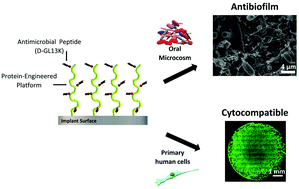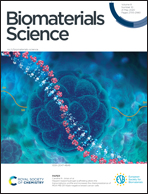Antibiofilm coatings based on protein-engineered polymers and antimicrobial peptides for preventing implant-associated infections†
Abstract
Implant-associated infections (IAIs) are one of the leading concerns in orthopedics and dentistry as they commonly lead to implant failure. The presence of biofilms and, increasingly frequently, drug-resistant bacteria further impairs the efficacy of conventional antibiotics. Immobilization of antimicrobial peptides (AMPs) on implant surfaces is a promising alternative to antibiotics for prevention of IAIs. In addition, the use of functional linkers for the AMP tethering enables to increase the antimicrobial potential and the bioactivities of the coating. In this study, an extracellular-matrix-mimicking system based on elastin-like recombinamers (ELRs) has been developed for the covalent anchoring of AMPs and investigated for use as a hybrid antibiofilm coating. A drip-flow biofilm reactor was used to simulate in vivo environmental dynamic conditions, thus showing that the presence of the AMPs in the hybrid coatings provided strong antibiofilm activity against monospecies and microcosm biofilm models of clinical relevance. These results, together with an excellent cytocompatibility towards primary gingival fibroblasts, encourage the use of ELRs as multivalent platforms for AMPs and open up a wide range of possibilities in the biofabrication of advanced coatings combining the antibiofilm potential of AMPs and the outstanding tunability and biomechanical properties of the ELRs.



 Please wait while we load your content...
Please wait while we load your content...
